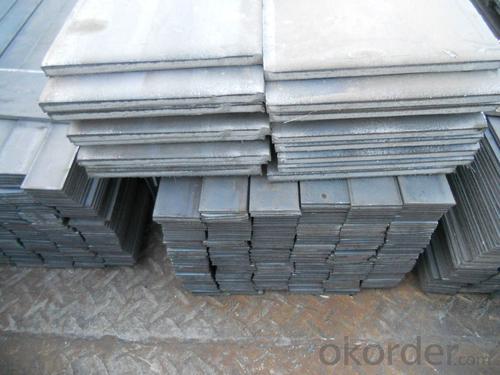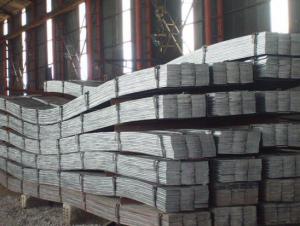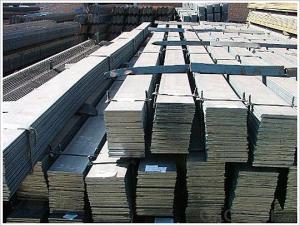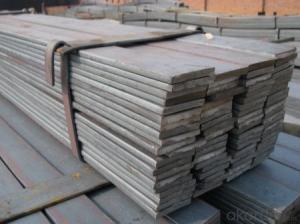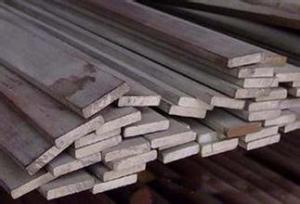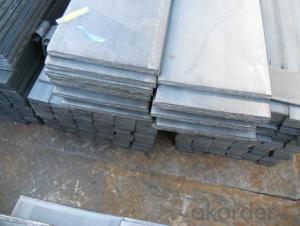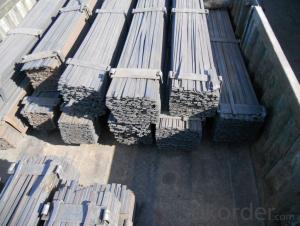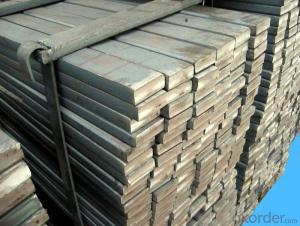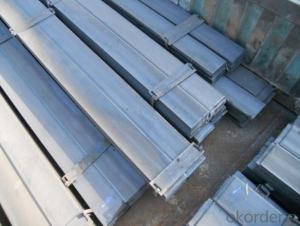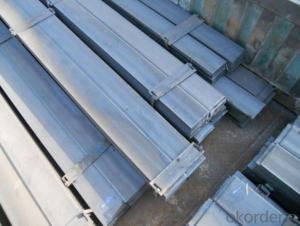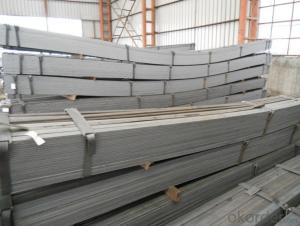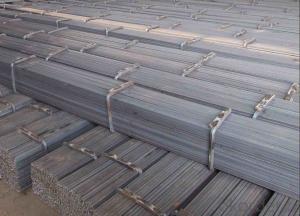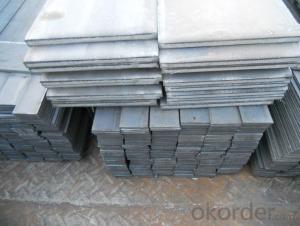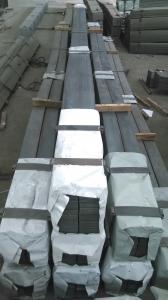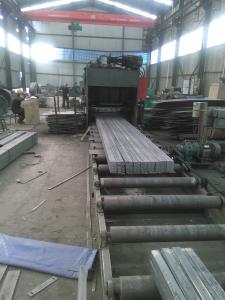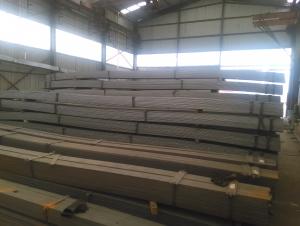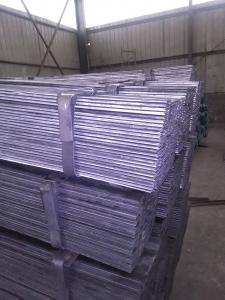Standard Size Q235 Hot Rolled Steel Flats from China
- Loading Port:
- China main port
- Payment Terms:
- TT or LC
- Min Order Qty:
- 50 m.t.
- Supply Capability:
- 200000 m.t./month
OKorder Service Pledge
OKorder Financial Service
You Might Also Like
Details of Standard Size Q235 Hot Rolled Steel Flats from China
| Minimum Order Quantity: | 25MT | Unit: | m.t. | Loading Port: | China Main Port |
| Supply Ability: | 80000-100000MTS/YEAR | Payment Terms: | TT or LC |
Specification of Standard Size Q235 Hot Rolled Steel Flats from China
Commodity: Q235 Steel Flat Bar
Standard: GB
Material: Q235
Brand name: FLATSPACE
Origin place: China
Thickness: 3mm-30mm
Width:20mm-200mm
Length: Max 12m
Certification: SGS/BV
Chemical composition of Standard Size Q235 Hot Rolled Steel Flats from China
Alloy No | Grade | Element(%) | ||||
C
| Mn
| S
| P
| Si
| ||
Q235
|
B
|
0.12—0.20 |
0.3—0.7 |
≤0.045 |
≤0.045
|
≤0.3
|
Physical properties of Standard Size Q235 Hot Rolled Steel Flats from China
Alloy No | Grade | Yielding strength point(Mpa) | Tensile strength (Mpa) | Elongation after fracture(%) | ||||||
Thickness (mm) | Thickness (mm) | |||||||||
≤16 | >16--40 | >40--60 | >60--100 |
| ≤16 | >16--40 | >40--60 | >60--100 | ||
≥ | ≥ | |||||||||
Q235 |
B |
235 |
225 |
215 |
205 |
375--500 |
26 |
25 |
24 |
23 |
Usage/Applications of Standard Size Q235 Hot Rolled Steel Flats from China
Widely used for construction, Machinery manufacturing, Iron tower steel structure, Shipbuilding; Steel grating, Staircase, Bridge, Viaduct, Railway spare parts, Boilers making etc.
Production Flow of Standard Size Q235 Hot Rolled Steel Flats from China
The steel flat bar is made through three processes:
1.Feeding the material: Feeding the row material (the steel plate) to Slitting Line.
2.Slitting:The steel plate would be slitted into expected width by lengthways cutter.
3. Leveled and cutting: The plat bar would be ground into level by the grinder and then cut into required length.
Packaging & Delivery of Standard Size Q235 Hot Rolled Steel Flats from China
Packaging Details: The Steel Flat Bars are packed in bundles and loaded in 20 feet/40 feet container, or shipped by bulk cargo ,also we can do as customer's requirements.
Delivery Details:30~45 days upon the receipt of buyer payment by T.T. or L/C.
Pictures of Standard Size Q235 Hot Rolled Steel Flats from China
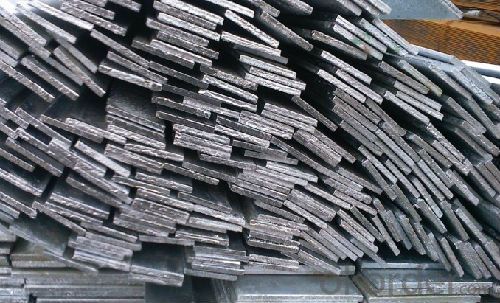
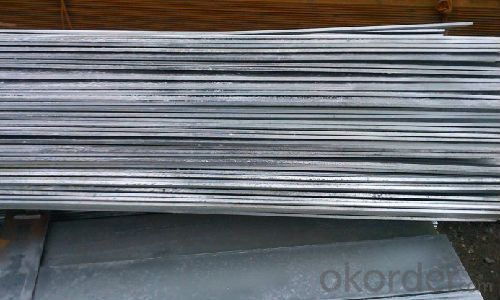
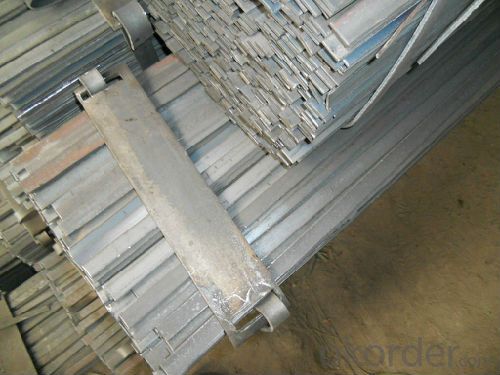
- Q: Are steel flat bars resistant to chemical exposure?
- Yes, steel flat bars are generally resistant to chemical exposure. Steel is known for its high resistance to chemical reactions, making it suitable for various applications where exposure to chemicals is a concern. However, the specific level of resistance can vary depending on the type of steel and the chemicals involved, so it is always advisable to consult the manufacturer or conduct proper testing for a particular chemical environment.
- Q: How do steel flat bars compare in terms of strength and durability?
- Steel flat bars are known for their exceptional strength and durability. They are one of the strongest and most durable materials available in the construction industry. Compared to other materials like wood or aluminum, steel flat bars possess a significantly higher strength-to-weight ratio, making them an ideal choice in applications where structural integrity is of utmost importance. The strength of steel flat bars is derived from their composition and manufacturing process. Steel is an alloy composed primarily of iron and carbon, with trace amounts of other elements. The carbon content in steel determines its strength, with higher carbon content resulting in greater strength. Additionally, the manufacturing process of steel flat bars involves hot rolling, cold rolling, or extrusion, which further enhances their strength by aligning the grains of the steel. In terms of durability, steel flat bars are highly resistant to corrosion, weathering, and wear. This is due to their inherent properties, as well as various protective coatings that can be applied to the surface of the bars, such as galvanization or painting. These coatings provide an additional layer of protection against rust and other forms of deterioration, ensuring the longevity and durability of steel flat bars in various environments. Furthermore, steel flat bars are capable of withstanding heavy loads, impacts, and extreme temperatures without compromising their structural integrity. This makes them suitable for a wide range of applications, including construction, manufacturing, transportation, and infrastructure projects. In conclusion, steel flat bars excel in terms of strength and durability when compared to other materials. Their high strength-to-weight ratio, resistance to corrosion and wear, and ability to withstand heavy loads and extreme conditions make them a reliable and long-lasting choice for various applications.
- Q: How large is the flat steel used for equipotential grounding?
- 3.2.15 general equipotential connection with the sectional area of protective bonding conductors, shall not be less than the maximum protection of conductor size distribution line 1/2, protective bonding conductor cross-sectional area of the minimum and maximum value shall comply with the provisions of table 3.2.15.
- Q: Is there a requirement for the ground resistance of the field motor? Is it good to use ground flat steel or ground wire?
- The grounding steel is better, the resistance is small, and the wiring is convenient, and the grounding is flat steel.
- Q: Can steel flat bars be used for manufacturing kitchen equipment or appliances?
- Yes, steel flat bars can be used for manufacturing kitchen equipment or appliances. Steel is a popular choice for such applications due to its durability, resistance to corrosion, and ease of cleaning. Steel flat bars can be shaped and fabricated into various components, such as shelves, brackets, or frames, that are commonly found in kitchen equipment and appliances.
- Q: What are the different methods of surface coloring or tinting for steel flat bars?
- There are multiple techniques available for coloring or tinting steel flat bars, each offering its own benefits. These methods can enhance the steel's appearance, protect against corrosion, or achieve both objectives. Some commonly used techniques include: 1. Painting: Painting is widely employed to add color to steel flat bars. It involves applying a layer of paint in the desired shade. This method not only provides color but also safeguards the steel against rust and corrosion. 2. Powder coating: Another popular method is powder coating, which entails applying a dry powder onto the steel surface. The powder is electrically charged and adheres to the steel, resulting in a durable and visually appealing coating. Powder coating offers a wide range of color options and exhibits excellent resistance to chipping, scratching, and fading. 3. Anodizing: Anodizing is typically used to color aluminum, but it can also be utilized for steel. This method involves forming a protective oxide layer on the steel's surface through an electrolytic process. The oxide layer can be dyed, resulting in a vibrant and long-lasting finish. 4. Galvanizing: Galvanizing primarily serves as a corrosion protection method, but it also imparts a silver-gray appearance to steel flat bars. This technique involves applying a layer of zinc to the steel through hot-dip or electroplating processes. Galvanized steel is highly durable and resistant to rust. 5. Chemical coloring: Chemical coloring involves treating the steel with various chemical solutions to achieve different colors. This technique can produce unique and decorative finishes, such as black oxide, bronze, or iridescent coatings. The colors obtained through chemical coloring are typically permanent and do not compromise the steel's structural integrity. 6. Patination: Patination refers to the natural aging process that occurs on steel surfaces over time, resulting in distinct colors and textures. However, this process can be accelerated by using chemicals or exposing the steel to specific environmental conditions. Patination can create varying shades of brown, green, or blue, giving steel flat bars a distinctive and weathered appearance. It is important to consider factors such as desired aesthetics, durability requirements, and intended applications when choosing a coloring method for steel flat bars.
- Q: Are steel flat bars suitable for architectural cladding?
- Yes, steel flat bars can be suitable for architectural cladding. Steel is a popular material choice for cladding due to its durability, strength, and versatility. Steel flat bars can be used to create sleek and modern designs for architectural cladding applications. They can be easily shaped, cut, and welded to achieve the desired look and can be finished with various surface treatments such as galvanizing, powder coating, or painting to enhance their aesthetic appeal and protect against corrosion. Steel flat bars can be used as vertical or horizontal elements in cladding systems, providing structural support and creating visually appealing facades. Additionally, steel is a sustainable material that can be recycled, making it an environmentally friendly choice for architectural cladding. However, it is important to consider the specific requirements of the project, such as the local climate conditions, maintenance requirements, and the desired design aesthetic, to determine if steel flat bars are the most suitable option for the specific architectural cladding application.
- Q: Can steel flat bars be used for making hand tools or equipment?
- Yes, steel flat bars can be used for making hand tools or equipment. Steel is a strong and durable material that is commonly used in the manufacturing of various tools and equipment. Flat bars are versatile and can be easily shaped and formed into different designs and sizes to meet the specific requirements of hand tools or equipment. Additionally, steel flat bars provide excellent strength and stability, making them suitable for applications where durability and reliability are essential. Furthermore, steel is resistant to corrosion, which ensures that the hand tools or equipment made from steel flat bars will have a longer lifespan. Overall, steel flat bars are a popular choice for making hand tools or equipment due to their strength, versatility, and durability.
- Q: What is the maximum thickness-to-width ratio for steel flat bars?
- The maximum thickness-to-width ratio for steel flat bars can vary depending on the specific grade and type of steel being used. However, in general, the maximum thickness-to-width ratio for steel flat bars is typically around 1:10. This means that the thickness of the bar should not exceed 10 times its width. It is important to note that this ratio may vary based on the specific application and industry standards, so it is always advisable to consult relevant engineering codes and standards to determine the maximum thickness-to-width ratio for a specific steel flat bar.
- Q: Can steel flat bars be painted or coated?
- Indeed, one can indeed paint or coat steel flat bars. Steel, being a versatile material, lends itself easily to painting or coating in order to enhance its aesthetics, shield it from corrosion, and augment its resistance against wear and tear. Painting steel flat bars accomplishes not only the addition of visual appeal, but also acts as a safeguard against rust and other environmental elements. Likewise, the application of coatings such as powder coating, galvanizing, or electroplating can further bolster the sturdiness and longevity of steel flat bars. These coatings supply supplementary protection against corrosion and can also confer specific functional attributes, such as resistance to heat or chemicals. Therefore, the practice of painting or coating steel flat bars is widely adopted to improve their appearance and optimize their performance across various applications.
Send your message to us
Standard Size Q235 Hot Rolled Steel Flats from China
- Loading Port:
- China main port
- Payment Terms:
- TT or LC
- Min Order Qty:
- 50 m.t.
- Supply Capability:
- 200000 m.t./month
OKorder Service Pledge
OKorder Financial Service
Similar products
Hot products
Hot Searches
Related keywords



